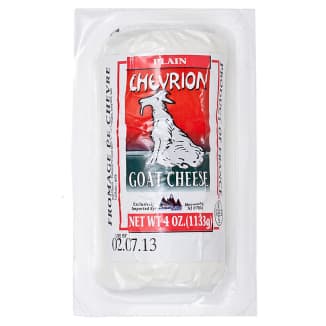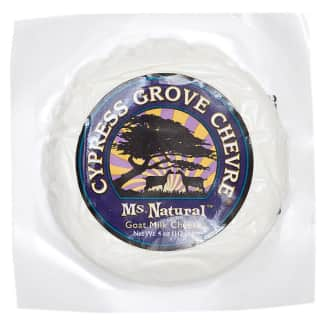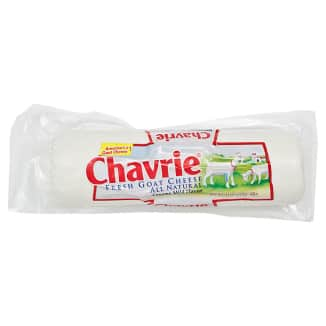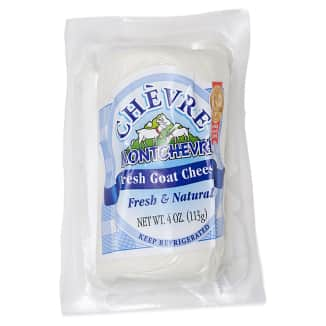Reviews You Can Trust.
See Why.
Goat Cheese
Why do some goat cheeses boast creamy texture and a bright and lemony taste, while others are chalky, gamy, or—worse—utterly flavorless?
Editor&aposs Note:UpdateFebruary 2022
We've learned that our favorite goat cheese has a new name. It is now known as Laura Chenel Original Fresh Goat Cheese Log.
Looking for more? Read our taste test of 15 different styles of goat cheese.
Top Pick

WinnerLaura Chenel Original Fresh Goat Cheese Log
“Rich-tasting,” “grassy,” and “tangy,” our favorite goat cheese was “smooth” and “creamy” both unheated and baked, and it kept its “lemony, bright flavor” in both iterations. A high salt content helped: Salt not only enhances flavor but also contributes to keeping the cheese creamy when heated.
pH: 4.05
Fat: 21.20 g in 100 g (6 g in 1-oz serving)
Salt: 1,053 mg in 100 g
Made In: California
Price at Time of Testing: $7.99 for 8-oz log ($15.98 per lb)
“Rich-tasting,” “grassy,” and “tangy,” our favorite goat cheese was “smooth” and “creamy” both unheated and baked, and it kept its “lemony, bright flavor” in both iterations. A high salt content helped: Salt not only enhances flavor but also contributes to keeping the cheese creamy when heated.
pH: 4.05
Fat: 21.20 g in 100 g (6 g in 1-oz serving)
Salt: 1,053 mg in 100 g
Made In: California
Price at Time of Testing: $7.99 for 8-oz log ($15.98 per lb)
Sign up for the Well-Equipped Cook newsletter
Shop smarter with our ATK Reviews team's expert guides and recommendations.
What You Need to Know
In 1981, Alice Waters topped a simple green salad with a round of baked goat cheese at her Berkeley restaurant, Chez Panisse. The tangy creaminess of this supple cheese was a revelation to most Americans. For centuries, France was the primary producer of goat cheese—chèvre in French means goat—and at that point, it was scarcely produced (or even found) domestically. In fact, Waters’s cheese came from a neighbor who kept goats and had learned to make it in France. But Waters was onto something. With that salad, a trend was born. Americans quickly developed a taste for this tangy fresh cheese.
Since then, the United States has seen a boom in goat-cheese making. Production has increased every year since 2002, according to U.S. Department of Agriculture figures, and dairy goat operations can now be found in 43 of the 50 states. The number of goat cheese entries in annual competitions sponsored by the American Cheese Society has doubled since 2005, and the sales of both domestic and imported goat cheese in supermarkets have experienced a huge surge—a whopping 10 percent increase in 2010 alone.
It’s not hard to see why fresh goat cheese is so popular: With its unmistakable tang, it can be eaten straight on crackers, enliven the simplest salad or pasta dish, enhance pizza toppings, and add creamy richness to sautéed greens. With so many new domestic choices now available, which one comes out on top? We gathered nine widely available samples (seven of them stateside products), ranging from $0.82 to $1.63 per ounce, and set to work finding out.
The Whole Schmear
We first tasted the cheese straight out of the package on plain crackers. Then, to see if heat changed its character, we rolled it in bread crumbs and baked it. The good news: Sampled straight from the fridge, the majority of our nine selections were smooth and creamy, with a distinctly tangy, grassy taste—just what we want in goat cheese. Only a few had issues, including a chalky, Spackle-like texture; a too-neutral flavor that seemed more like cream cheese than like goat cheese; or an overly gamy taste, reminiscent of a “barnyard” or even “lamb fat.”
When we baked them, the gamiest samples mellowed to a gentler but still present tang, inspiring descriptions like “savory” and “goaty in a good way.” That made sense when we learned that the compounds that set up gamy flavors in goat cheese are volatile and flash off in the oven’s heat. Heat’s impact on texture, though, was another story. Products that were chalky straight out of the package didn’t improve with baking—and several that were creamy sampled plain surprised us by baking into crumbly, grainy blobs.
Since baking goat cheese isn’t something that we do every day, we tried another recipe, warming our favorite and least favorite goat cheese samples in pasta. Same problem, new variation: Tossed with hot pasta, the lowest-ranked cheese, which had turned crumbly when baked, transformed into a grainy paste, with bits of cheese visible in the mix. The top product, which had stayed creamy and intact when baked, melted nicely into a cohesive sauce with the pasta.
Despite the samples’ different responses to heat, at the end of our taste trials, we liked six of the nine products. With just three ingredients on the label—pasteurized goat’s milk, enzymes, and salt—what made these products stand out?
Milk and Make
Perhaps unsurprisingly, the flavors in goat cheese begin with the animal’s diet. Unlike cows, goats are browsers, not grazers. Their strong stomachs can tolerate many bitter plants that cows avoid, and if left to feed in an open pasture, they gravitate toward shrublike plants that are close to the ground and that can have a pungent taste. Their milk picks up these acrid flavors, so cheesemakers aiming for a tangy but still grassy-sweet profile make sure to source the goats’ milk from animals on a restricted diet of mild-tasting grains, grasses, and hay. These nanny goats must also be kept separate from male bucks, or billies, during milking: The powerful scent of the billies raises the nannies’ hormone levels, charging up the flavor of their milk and giving it a barnyard taste.
The freshness of the milk is also essential to an optimal flavor profile in the cheese: Producers either milk their own goats or source the milk from nearby farms and use it within a few days of milking. Freezing the milk is not a desirable option. The sharp drop and then spike in temperature when the milk is defrosted damages the membrane protecting the milk fat from the lipase enzyme, which in turn releases three fatty acids: capric, caproic, and caprylic. While a moderate amount of these fatty acids is desirable—they give goat cheese its characteristic tangy flavor—too much is a bad thing. Rough handling can also lead to the release of too many fatty acids.
Though all of the makers of the products in our lineup assured us that they paid close attention to each of these considerations—setting strict specifications for the milk they use, handling it carefully, and never freezing it—there must have been more variation than producers would admit to, given the range of flavors that we detected. Still seeking concrete answers regarding the differences in flavor and texture, we looked next at the cheese-making process itself. After it’s pasteurized (a measure taken by all of the companies in our lineup), the milk goes into closed fermentation tanks, where bacterial cultures are traditionally added. Over the next several hours, the bacteria produce enzymes that cause the pH of the milk to drop, separating the mixture into curds and whey. After hanging the curds in cheesecloth bags or in bundles to drain, the cheesemaker adds salt and then presses the cheese into the familiar log or medallion shape.
Most of the samples in our lineup used the traditional approach to curdling the cheese: adding bacterial cultures in the form of ripened curds from an earlier cheese making. But one product used the so-called quick-set method, adding citric or lactic acid directly to the milk to trigger faster curdling. Cheese experts told us that this shortcut can turn the cheese slightly grainy or chalky, a problem that we noticed in this cheese and that only worsened when it was baked.
Beyond this one particular variable, however, we were still at a loss as to why some cheeses had a different taste and texture than others. So we sent them to an independent lab for some closer scrutiny, having each sample tested for fat, salt, and pH levels. These tests showed that fat didn’t matter, since one of the leanest products fared well with tasters on both flavor and texture in each trial. Ditto for pH: With one exception, the levels were all very close. That left salt.
The Power of Salt
If goat-cheese makers disagree about anything, it’s the amount of salt that should go into the finished product. The salt content in these samples ranged from 1,200 milligrams in 100 grams down to considerably less than half of that, or 441 milligrams per 100 grams. Though some cheesemakers deliberately keep the salt to a minimum because they maintain that it can cancel out the clean, citrusy taste of goat cheese, we preferred the samples with the most sodium, while those with the least amounts tasted “neutral,” or even “flat.” We weren’t that surprised, since salt can enhance many flavors already present in food. What did surprise us was that salt’s benefits didn’t stop with flavor. Products with more salt also stayed smooth and cohesive when baked, whereas those with less salt were described as “mealy” or “crumbly.”
Cheese scientists at the University of Wisconsin explained that the ions in salt help the proteins in cheese bind and retain water, which in turn means that more moisture is retained during cooking and that the cheese melts more smoothly. “That is why you have a creamy, smooth texture after baking with the higher-salt goat cheeses,” noted Bénédicte Coude, assistant coordinator of the Cheese Industry and Applications Program at the Wisconsin Center for Dairy Research. Adding salt helps only up to a point, however. “Cheese that is very salty will readily lose its water during baking,” said senior scientist Mark Johnson. That’s why cheeses like cheddar and Parmesan, which typically have significantly more salt, can separate when baked.
With a taste enhancing 1,053 milligrams of salt in 100 grams, our favorite product was “mildly goaty” and “rich-tasting,” with a “grassy” and “tangy” finish straight out of the package. Either baked or tossed with hot pasta, it stayed “lemony” and “bright,” with a “creamy, buttery texture.” It is the same goat cheese that Alice Waters used at Chez Panisse some 30 years ago. In 2006, Waters’s neighbor, the cheesemaker, sold her business to the Rians Group, a French company, but kept her goats. These animals continued to supply milk for the brand until 2010, when the cheesemaker retired completely—but according to the Rians Group, the recipe remains the same. In every taste trial, this cheese landed at the top of the heap.
America's Test KitchenWatch Now
Everything We Tested
Recommended

WinnerLaura Chenel Original Fresh Goat Cheese Log
“Rich-tasting,” “grassy,” and “tangy,” our favorite goat cheese was “smooth” and “creamy” both unheated and baked, and it kept its “lemony, bright flavor” in both iterations. A high salt content helped: Salt not only enhances flavor but also contributes to keeping the cheese creamy when heated.
pH: 4.05
Fat: 21.20 g in 100 g (6 g in 1-oz serving)
Salt: 1,053 mg in 100 g
Made In: California
Price at Time of Testing: $7.99 for 8-oz log ($15.98 per lb)
“Rich-tasting,” “grassy,” and “tangy,” our favorite goat cheese was “smooth” and “creamy” both unheated and baked, and it kept its “lemony, bright flavor” in both iterations. A high salt content helped: Salt not only enhances flavor but also contributes to keeping the cheese creamy when heated.
pH: 4.05
Fat: 21.20 g in 100 g (6 g in 1-oz serving)
Salt: 1,053 mg in 100 g
Made In: California
Price at Time of Testing: $7.99 for 8-oz log ($15.98 per lb)

Vermont Creamery Fresh Goat Cheese, Classic Chèvre
“Smooth and creamy” and with a “slightly citrusy,” “clean, lactic” taste, this was one of our favorite goat cheeses for sampling straight from the package. Its moderate salt content allowed it to turn slightly “mealy” when baked, but its “grassy,” “citruslike” flavors continued to earn raves from tasters.
pH: 3.95
Fat: 20.96 g in 100 g (5.9 g in 1-oz serving)
Salt: 784 mg in 100 g
Made In: Vermont
Price at Time of Testing: $4.99 for 4 oz ($1.25 per oz)
“Smooth and creamy” and with a “slightly citrusy,” “clean, lactic” taste, this was one of our favorite goat cheeses for sampling straight from the package. Its moderate salt content allowed it to turn slightly “mealy” when baked, but its “grassy,” “citruslike” flavors continued to earn raves from tasters.
pH: 3.95
Fat: 20.96 g in 100 g (5.9 g in 1-oz serving)
Salt: 784 mg in 100 g
Made In: Vermont
Price at Time of Testing: $4.99 for 4 oz ($1.25 per oz)

Chevrion Plain Goat Cheese
This “tangy,” “creamy” sample was “very strong” and “goaty” eaten unheated, but it mellowed to “bright, tangy, and sweet” when baked, when it also retained a “luscious” texture, thanks to its high salt content.
pH: 3.91
Fat: 16.89 g in 100 g (4.8 g in 1-oz serving)
Salt: 1,200 mg in 100 g
Made In: France
Price at Time of Testing: $4.29 for 4 oz ($1.07 per oz)
This “tangy,” “creamy” sample was “very strong” and “goaty” eaten unheated, but it mellowed to “bright, tangy, and sweet” when baked, when it also retained a “luscious” texture, thanks to its high salt content.
pH: 3.91
Fat: 16.89 g in 100 g (4.8 g in 1-oz serving)
Salt: 1,200 mg in 100 g
Made In: France
Price at Time of Testing: $4.29 for 4 oz ($1.07 per oz)

Cypress Grove Chèvre Ms. Natural Goat Milk Cheese
Unheated, this cheese wowed us with “lemony,” “grassy” flavors and a “smooth,” “melts-in-your-mouth” texture. Though baking dried out its texture a bit, tasters still gave it an enthusiastic thumbs-up.
pH: 4.04
Fat: 21.55 g in 100 g (6.1 g in 1-oz serving)
Salt: 955 mg in 100 g
Made In: California
Price at Time of Testing: $6.50 for 4 oz ($1.63 per oz)
Unheated, this cheese wowed us with “lemony,” “grassy” flavors and a “smooth,” “melts-in-your-mouth” texture. Though baking dried out its texture a bit, tasters still gave it an enthusiastic thumbs-up.
pH: 4.04
Fat: 21.55 g in 100 g (6.1 g in 1-oz serving)
Salt: 955 mg in 100 g
Made In: California
Price at Time of Testing: $6.50 for 4 oz ($1.63 per oz)

Sierra Nevada Cheese Co. Bella Capra Chèvre
“Fresh” and “tangy” and with a “creamy” texture when sampled unheated, this cheese with a moderate salt content turned a little “crumbly” when baked but still offered “tang” and “good goat flavor.”
pH: 3.86
Fat: 25.56 g in 100 g (7.2 g in 1-oz serving)
Salt: 882 mg in 100 g
Made In: California
Price at Time of Testing: $7.99 for 8 oz ($1.00 per oz)
“Fresh” and “tangy” and with a “creamy” texture when sampled unheated, this cheese with a moderate salt content turned a little “crumbly” when baked but still offered “tang” and “good goat flavor.”
pH: 3.86
Fat: 25.56 g in 100 g (7.2 g in 1-oz serving)
Salt: 882 mg in 100 g
Made In: California
Price at Time of Testing: $7.99 for 8 oz ($1.00 per oz)

Chavrie Fresh Goat Cheese
Though it had some fans, the “barnyard” and “gamy” flavor of this cheese reminded some tasters of “lamb fat.” These flavors dissipated in baking, when this sample shone with a “tasty tang and milky flavor” and a “nice creamy texture.”
pH: 4.66
Fat: 22.86 g in 100 g (6.5 g in 1-oz serving)
Salt: 1,078 mg in 100 g
Made In: Pennsylvania
Price at Time of Testing: $8.99 for 11 oz ($0.82 per oz)
Though it had some fans, the “barnyard” and “gamy” flavor of this cheese reminded some tasters of “lamb fat.” These flavors dissipated in baking, when this sample shone with a “tasty tang and milky flavor” and a “nice creamy texture.”
pH: 4.66
Fat: 22.86 g in 100 g (6.5 g in 1-oz serving)
Salt: 1,078 mg in 100 g
Made In: Pennsylvania
Price at Time of Testing: $8.99 for 11 oz ($0.82 per oz)
Recommended with reservations

Montchèvre Fresh Goat Cheese
Though “very creamy” and with a “nice smooth consistency” when unheated, without much salt, it was “neutral” to many and just “mildly tangy.” Too little salt also left it “watery and crumbly” when baked.
pH: 4.27
Fat: 24.49 g in 100 g (6.9 g in 1-oz serving)
Salt: 686 mg in 100 g
Made In: Wisconsin
Price at Time of Testing: $3.99 for 4 oz ($1.00 per oz)
Though “very creamy” and with a “nice smooth consistency” when unheated, without much salt, it was “neutral” to many and just “mildly tangy.” Too little salt also left it “watery and crumbly” when baked.
pH: 4.27
Fat: 24.49 g in 100 g (6.9 g in 1-oz serving)
Salt: 686 mg in 100 g
Made In: Wisconsin
Price at Time of Testing: $3.99 for 4 oz ($1.00 per oz)

Ile de France Chèvre Fresh Goat Cheese
Also low in salt, this sample had a pleasant but “mild-mannered” taste and “slightly chalky” texture when eaten from the package. Baking turned it “crumbly,” a flaw that was offset by its “subtle herb” flavor notes.
pH: 3.96
Fat: 22.95 g in 100 g (6.5 g in 1-oz serving)
Salt: 637 mg in 100 g
Made In: France
Price at Time of Testing: $10.99 for 10.5 oz ($1.05 per oz)
Also low in salt, this sample had a pleasant but “mild-mannered” taste and “slightly chalky” texture when eaten from the package. Baking turned it “crumbly,” a flaw that was offset by its “subtle herb” flavor notes.
pH: 3.96
Fat: 22.95 g in 100 g (6.5 g in 1-oz serving)
Salt: 637 mg in 100 g
Made In: France
Price at Time of Testing: $10.99 for 10.5 oz ($1.05 per oz)
Not Recommended

Coach Farm Natural Goat’s Milk Cheese
Its very low salt content didn’t do this cheese any favors. Unheated, it had a “chalky,” “puttylike” texture and “weak” taste. Baking didn’t redeem it: Most tasters found it “chalky” again, with “not enough goat” flavor.
pH: 3.93
Fat: 23.59 g in 100 g (6.7 g in 1-oz serving)
Salt: 441 mg in 100 g
Made In: New York
Price at Time of Testing: $4.50 for 4 oz ($1.13 per oz)
Its very low salt content didn’t do this cheese any favors. Unheated, it had a “chalky,” “puttylike” texture and “weak” taste. Baking didn’t redeem it: Most tasters found it “chalky” again, with “not enough goat” flavor.
pH: 3.93
Fat: 23.59 g in 100 g (6.7 g in 1-oz serving)
Salt: 441 mg in 100 g
Made In: New York
Price at Time of Testing: $4.50 for 4 oz ($1.13 per oz)
*All products reviewed by America’s Test Kitchen are independently chosen, researched, and reviewed by our editors. We buy products for testing at retail locations and do not accept unsolicited samples for testing. We list suggested sources for recommended products as a convenience to our readers but do not endorse specific retailers. When you choose to purchase our editorial recommendations from the links we provide, we may earn an affiliate commission. Prices are subject to change.
Reviews You Can Trust
The mission of America’s Test Kitchen Reviews is to find the best equipment and ingredients for the home cook through rigorous, hands-on testing. Have a question or suggestion? Send us an email at atkreviews@americastestkitchen.com. We appreciate your feedback!
Reviews You Can Trust.
See Why.







